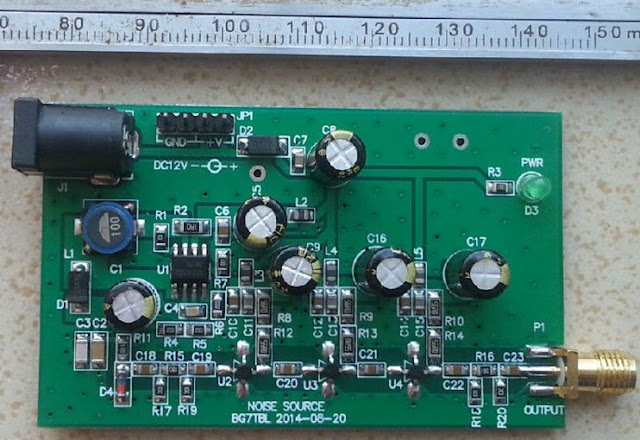Airspy, Spectrumspy, noise source and UHF cavity filter characteristics; a low cost spectrum analyzer?
Airspy, SpectrumSpy, noise source and UHF cavity filter characteristics; a low cost spectrum analyzer?
Introducton
A basic spectrum analyzer/tracking generator for less than $250? Yes. Can it be used to do a demanding task like tuning a UHF cavity filter from a repeater? Seems so.The "proof of concept", spectrum analyzer software, SpectrumSpy, can be used with the Airspy SDR and a noise source to show the characteristics of a pass-reject UHF cavity filter.
SpectrumSpy and Airspy
SpectrumSpy, "proof of concept", spectrum analyzer software is a new addition to the SDR# download for use with the Airspy SDR. It has the potential for a new direction with low cost SDRs, spectrum analyzers. Spectrum analyzers are expensive; $1500 then skyward. SpectrumSpy: http://airspy.com/download/ (separate executable in SDR# folder).Airspy has a 24 – 1800 MHz native RX range, but down to DC with the SpyVerter option. http://airspy.com/ $199 and US$59
An earlier post is of SpectrumSpy used as a spectrum analyser: http://vk4zxi.blogspot.com.au/2016/04/low-cost-spectrum-analyser-scanner-with.html
However, a spectrum analyzer needs a tracking generator to be really useful and to test radio filters. A noise source can be used to achieve much the same purpose.
Noise source
A low cost Zenar diode based noise source is available for about $20. It uses three Mini-Circuits ERA-5+ wideband amplifiers (DC-4 GHz) to get the noise to a usable level.I did a quick check of the white noise with SpectrumSpy right up to 1 GHz. The level dropped a little with frequency, but that could be either the noise source or Airspy.
http://www.ebay.com/itm/SMA-noise-source-Simple-spectrum-external-tracking-source-DC-12V-0-3A-/111831285650?hash=item1a09a9ff92:g:K0UAAOSwnipWUtgZ and many others.
Noise source output
Cavity filter characteristics
A cavity filter is part of a duplexer that allows a radio repeater to simultaneously transmit and receive with the same antenna, an amazing feat in itself and one of my other interests. Duplexers are fairly complex in design and setup.Pass/reject is one type of cavity filter that passes the receive signal on one frequency, but rejects the re-transmit of the repeater on another frequency with a notch for the receive side of the duplexer and the opposite for the transmit side.
An expensive spectrum analyzer/tracking generator is needed to adjust the pass and reject frequencies and to minimize losses.
However, SpectrumSpy with a noise source does a pretty good job. The shape, frequencies and depth of notch (>30 dB) are about right in this very preliminary test.
Characteristics of single cavity filter using SpectrumSpy and noise source
Spectrum analyzer/tracking generator plot of similar but different filter.
Typical characteristics from half a duplexer (two cavities) with my old HP spectrum analyzer and tracking generator ($12K in 1990s and about $1000 secondhand now). (I will do it for the same filter another time and edit.) It has different tuning to the one in this post, hence the mirrored shape. http://vk4zxi.blogspot.com.au/2016/02/duplexer-isolation-limits-of.htmlDiscussion
Airspy with SpectrumSpy does a good job in this demanding task. It probably could be used to tune a duplexer; amazing for the very low cost.Two immediate issues however. First, SpectrumSpy is not calibrated or necessarily linear. Second, it does not have the bells and whistles of a spectrum analyzer such as digital analysis and data, or amplitude/frequency markers.
SpectrumSpy is proof of concept of an SDR used as a spectrum analyzer. This is a very good additional application for low cost SDRs, normally used as receivers. Similar software could be developed for other SDRs, as has been done, but less successfully, for the RTL-SDRs.




Comments
Post a Comment